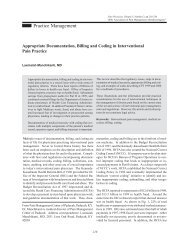ASIPP Practice Guidelines - Pain Physician
ASIPP Practice Guidelines - Pain Physician
ASIPP Practice Guidelines - Pain Physician
Create successful ePaper yourself
Turn your PDF publications into a flip-book with our unique Google optimized e-Paper software.
Manchikanti et al • <strong>ASIPP</strong> <strong>Practice</strong> <strong>Guidelines</strong><br />
30<br />
12%<br />
Children and<br />
adolescents<br />
15%<br />
Adults<br />
27%<br />
Elderly<br />
Fig. 1. Estimated average of age related prevalence of<br />
low back pain<br />
Reproduced with permission from Manchikanti (103)<br />
pain intensity with moderate or severe disability, whereas<br />
an additional 12% suffer with high pain intensity but with<br />
a low disability. In a similar study, Cote et al (119, 120),<br />
evaluating neck pain and its related disability, reported that<br />
overall, 39% of the sample experienced grade I neck pain,<br />
whereas 9% experienced grade II neck pain, and 5% had<br />
grade III and IV neck pain (Table 2). Almost 16% of the<br />
respondents reported having previously injured the neck<br />
in a motor vehicle collision (119, 120).<br />
Duration of back pain and its chronicity have been a topic<br />
of controversy. It is believed that most of these episodes<br />
will be short-lived, with 80% to 90% of attacks resolving<br />
in about 6 weeks irrespective of the administration or type<br />
of treatment; and 5% to 10% of patients developing persistent<br />
back pain (121, 122). However, this concept has<br />
been questioned, as the condition tends to relapse, so most<br />
patients will experience multiple episodes. As shown in<br />
Table 3, prevalence of low back pain ranged from 35% to<br />
79% at 3 months and 35% to 75% at 12 months (123-127).<br />
The studies evaluating the chronicity of low back pain estimated<br />
the average of age related prevalence of persistent<br />
low back pain as 12% in children and adolescents, 15% in<br />
adults, and 27% in the elderly (Fig. 1). Bressler and colleagues<br />
(101), in a systematic review of the literature determined<br />
that overall prevalence of low back pain in the<br />
elderly was 27% derived from a total elderly population<br />
base of 17,173 with reports from 12 studies from community<br />
population, primary care settings and from the nursing<br />
homes with prevalence ranging from 13% to 51% (101,<br />
109, 128-138).<br />
Chronic <strong>Pain</strong> vs Chronic <strong>Pain</strong> Syndrome<br />
Two major and controversial terms in today’s pain medicine<br />
are “chronic pain,” also known as persistent pain, and<br />
a second category known as “chronic pain syndrome,”<br />
which is a separate and distinct condition (139-142).<br />
Chronic pain or persistent pain persists beyond the expected<br />
healing time of an injury or an illness, usually considered<br />
beyond 6 months. Chronic pain may be associated with<br />
psychological problems such as depression, generalized<br />
anxiety disorder, and some behavioral problems. However,<br />
chronic pain improperly diagnosed or inadequately<br />
treated can result in deteriorating coping skills and limitations<br />
and reduction in functional capacity. In contrast,<br />
chronic pain syndrome is a complex condition with physical,<br />
psychological, emotional, and social components (141,<br />
142). Both chronic pain and chronic pain syndrome can<br />
be defined in terms of duration and persistence of the sensation<br />
of pain, and presence or absence of psychological<br />
and emotional components. However, chronic pain syndrome,<br />
as opposed to chronic pain, has the added component<br />
of certain recognizable psychological and socioeconomic<br />
influences, with characteristic psychological and<br />
sociological behavior patterns inherent in chronic pain syndrome<br />
that distinguish the two conditions (141). According<br />
to the fifth edition of Guides to Evaluation of Permanent<br />
Impairment published in 2000 (142), the term chronic<br />
pain syndrome even though not official nomenclature, is<br />
frequently used to describe an individual who is markedly<br />
impaired by chronic pain with substantial psychological<br />
overlay. The guides (142) also state that chronic pain syndrome<br />
is largely a behavioral syndrome that affects a minority<br />
of those with chronic pain. It may best be understood<br />
as a form of an abnormal illness behavior that consists<br />
mainly of excessive adoption of the sick role. The<br />
guides also caution that while the term is useful in certain<br />
situations, it does not, however, substitute for a careful diagnosis<br />
of physiologic, psychological, and conditioning<br />
components that comprise the syndrome. The term chronic<br />
pain syndrome must be used with caution, as grouping pain<br />
problems together under a general disorder may mask and<br />
leave untreated important physiologic differences (142).<br />
Thus, chronic pain may exist in the absence of chronic<br />
pain syndrome, but chronic pain syndrome always presumes<br />
the presence of chronic pain. The terminology recommended<br />
by IASP has eliminated chronic pain syndrome<br />
from the glossary (140). The IASP Task Force on Taxonomy<br />
on classification of chronic pain describing definitions<br />
of pain terms described that it is common in North<br />
America to find patients as having “chronic pain syndrome”<br />
(140). In this case, the Task Force believed that the words<br />
<strong>Pain</strong> <strong>Physician</strong> Vol. 4, No. 1, 2001
















